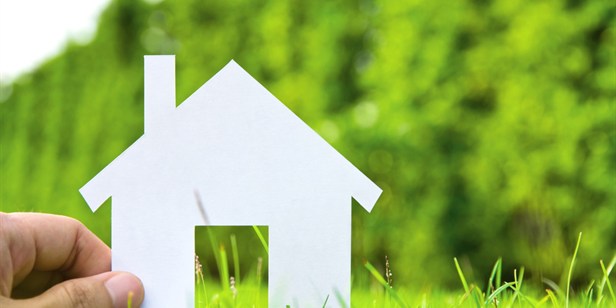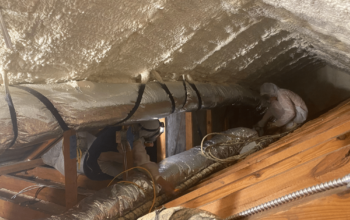How exciting! You’re on your way to building your dream home. This is an exhilarating and overwhelming endeavor. No doubt you’ve figured out most of the ins and outs of your new house, but have you considered going green?
You will thank yourself for creating an environmentally friendly home that won’t cause any negative impact on the world around you. Not only will your living space be healthier, you’ll thrive and enjoy it as well.
Greener is Better
Concrete holds most of our local business and homes together. From sidewalks to bridges it helps cities function, but unfortunately it’s not so eco-friendly. Commercial concrete releases the greenhouse gas carbon dioxide (CO2), which contributes to issues of climate change and global warming.
The good thing? Concrete is not the only material available to help build your home. There are other building substances you can use to lend a hand to the environment, rather than hurting it.
Have you considered straw? No need to worry about a big bad wolf coming to blow down this home. Properly sealed straw bales actually provide high levels of insulation and can replace other building materials like wood, concrete, plaster and fiberglass. They’re affordable and sustainable as straw is a rapidly renewable source.
How about grasscrete? Yes, you read correctly. Grasscrete is a method of using concrete, but leaves strategically placed open areas in patterns when laying the cement so grass or other plant life can grow. This is a great way to reduce the amount of concrete used and adds some greenery as well. Not to mention this method improves stormwater absorption and drainage.
Recycled plastic is a fabulous way to make something new out of something old. Reusing materials is one of the main components of having a green life, so instead of making new ones, why not keep some trash out of landfills and reuse. Whether you fill old bottles with mud or use a newer (soon-to-be available) method of making bricks from old plastic, this is a great eco-friendly idea.
Laying Your Foundation
Before you decide to start construction, consider your location. Your homesite quite literally establishes the foundation for your house. Choose wrong and you could still end up with a great building, but it might not be everything you’d imagined. You can change your home, but you can’t change the land.
Making a list of must-haves for your home’s location is a good first start. If you want a home that doesn’t get too hot, think about facing your home East. A west-facing home would mean more cooling costs.
If you want to ensure that you won’t be driving too often then check out the closest stores or shops. Walking, cycling or bus riding are options when it comes to getting where you need to go. Being close to businesses could help you do your part in avoiding the utilization of pollution-making vehicles.
If you want to steer clear of flooding and hurricane areas, make sure your foundation isn’t located in an environmentally sensitive place. According to the experts at http://www.homebuilders.construction/, deciding the location for your house is one of the most overlooked ways to incorporate green living into your home. Be mindful of where you lay your foundation.
Harvesting the Sun
Solar panels are a clean and renewable source of energy that use the natural power all around us from the sun. This is where your home’s location comes into play. Depending on where you place your solar panels and the position of your home, you may be able to collect ample amounts of power.
By generating energy from a properly designed solar array, you can possibly free yourself from electricity bills. But the change to greener living has its setbacks. You may be paying up to $10,000 for adequate installation and products, yet you can expect to see long-term savings in the future.
Using solar panels for your home could increase your ROI, therefore saving you some money in the long run. Combining Federal tax credit with the incentives you qualify in your state may significantly reduce the cost of your solar system as well. Each area is different, so look into how much the initial cost to install solar panels will run you before diving in. Energy saving can add more than power to your home.
High Quality H2O
With over 70% of the earth covered in water, it’s somewhat daunting to think that almost one billion of the world’s population doesn’t have access to clean, fresh water. Without H2O, life would be unimaginable. Creating your own source for usable water is a great way to exude cleaner and greener living.
One option is to collect rainwater from your roof and store it in a tank by using a rainwater harvesting system. Using a rain barrel is the most common method: a barrel is installed underneath the downspout of the guttering of your roof, then the water will be collected as it rains. The container itself will consist of a spigot and possibly a hose so you can get water when you need it. You can use this water for gardening, laundry and even toilets.
Another way to save some energy and space is by installing a tankless water heater. Water heats as it passes through the electric coil, ensuring that no water is wasted and that there’s zero wait time for the water to get warm. This helps in saving excess energy costs, and since the hot water tank is eliminated, ample storage room is at your disposal. Considering the other options of green living, they are fairly cheap to install as well.
Having an extra source of water or deleting a water tank from your home can help you save. From reducing erosion to money costs to saving time, you can’t go wrong with a rainwater harvesting system or a tankless water heater.
When constructing a productive eco-friendly house, you’ll want to cut down on your own personal use of waste producing products. By operating with less electricity, meaning turning off the lights or unplugging appliances, you’ll cut down on costs as well. Don’t forget to use recycled products when available, shower for a short amount of time and take your own reusable bags to the grocery store.
Going green will help all facets of life, including your wallet, so what are you waiting for?
Related Posts












